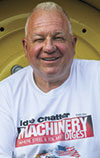Situation No. 1 You were blessed with a bumper crop of corn this year and had a forward contract with some pretty good pricing.
Due to this, you plan to put in a center pivot on some of your low CEC (cation exchange capacity) ground to keep it moist if the rain shuts off next year.
You are looking at a new pivot, but your cousin has a good irrigation pump with a 460 Ford gas engine on it. He said it always ran great but developed a metallic sound from the front of the engine. He thinks it may be a worn timing chain.
You would like to confirm that but do not want to take his engine apart and not take it. He tells you there is a way to check the timing chain from the outside, but he does not know how. You ask your friends, and they offer this advice:
A. Farmer A states that you can do this, but you need to remove a valve cover.
B. Farmer B is sure there is no way of getting around taking the timing cover off and looking inside.
C. Farmer C says a worn timing chain makes no noise, so it must be a main bearing.
D. Farmer D says you need to remove the spark plugs, turn the crankshaft backward two revolutions and stop at TDC (top dead center). Then remove the distributor cap and turn the engine slowly in the proper direction while watching the rotor. When it moves, stop. Read the timing mark on the balancer for wear.
Situation No. 2
The talk at the coffee shop turns to the automatic choke that engines had until they went to fuel injection. You recall how the engine would race with the choke on and how you needed to “kick it off the fast-idle cam.” One of the guys says that he never understood why the engine needed to fast idle. The others at the table chime in with:
A. Farmer A says the fast idle serves two purposes: It helps the engine overcome internal friction from being cold; it “blows open” the choke plate against spring tension.
B. Farmer B claims it was a way to get the heater working quicker in the winter.
C. Farmer C is adamant that the companies wanted the engine to race when it was cold to wear out faster.
D. Farmer D is a millennial and asks what an automatic choke is.
Situation No. 3
You are listening to the Idle Chatter podcast, and you hear about a torque angle gauge. However, you do not recall exactly what it is, so you ask your friends after church. This is what they tell you:
A. Farmer A says it is used to measure rotating torque, such as when checking a seed meter.
B. Farmer B says you put it on an impact gun when tightening lug nuts so you do not strip them.
C. Farmer C says it measures the angle of a PTO shaft.
D. Farmer D told you it is used when installing torque-to-yield bolts.
Answers
Situation No. 1: Farmer D is correct. You remove the spark plugs and distributor cap and turn the crankshaft backward two complete revolutions past TDC. This is to remove any slack from the timing chain. On the second revolution, you stop at TDC. Then with a helper watching the rotor, you slowly turn the crankshaft in the proper direction of rotation. As soon as the rotor begins to move, stop. Read the timing mark on the scale. That is the amount of stretch in degrees. If it is more than 3 degrees, the chain is worn. Often a worn timing chain will hit the timing cover and make a noise like a bearing but is less rhythmic.
Situation No. 2: Farmer A knows the correct answer. The purpose of the fast-idle cam and, in turn, the fast-idle speed, is to help the engine overcome internal friction when it is cold and blow open the choke plate against choke spring tension. This function works in conjunction with the choke pull-off or sometimes called the choke break.
Situation No. 3: Farmer D is correct. Many engines today, along with other applications, use torque-to-yield (TTY) bolts. They need to be first tightened to the proper torque and then rotated a specific number of degrees so the bolt enters the plastic range (permanently elongated). For example, the specification may be torque to 45 pound-foot and then rotate 27 degrees.











